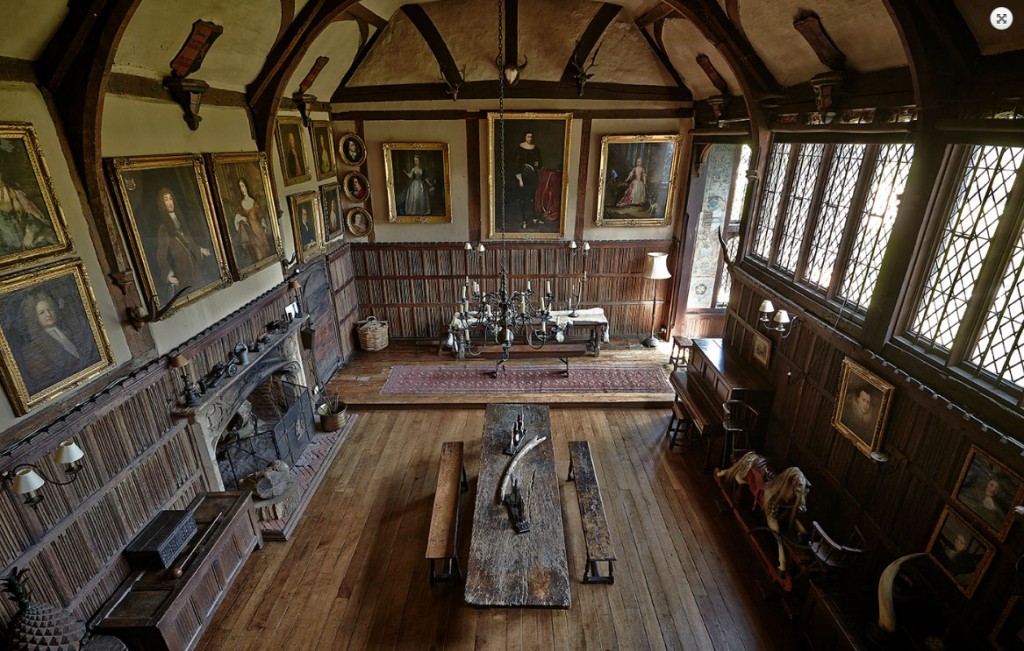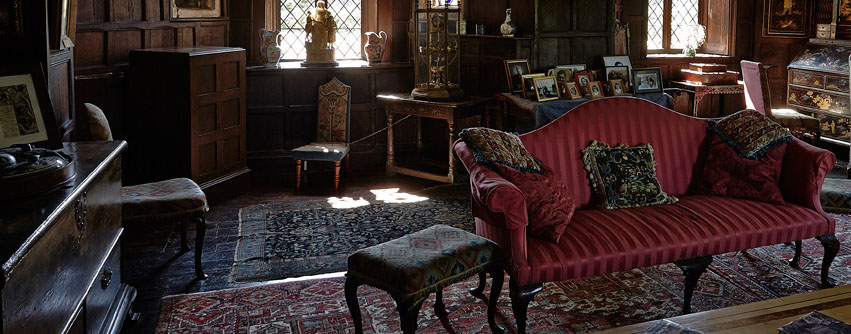Dorney Court is a Grade I listed Tudor manor house and is situated in the village of Dorney which lies on a slight rise in the Thames floodplain, Dorney means Island of Bumble Bees and the estate is renowned for its honey which is still produced to this day. The house has changed little since its 15th century origins. The first known record of a house at Dorney is dated just after the Norman Conquest.
The house is panelled in wood and contains many interesting treasures, paintings and artefacts and it even has a ghost. The upper floor rooms have barrel vaulted chambers, one of which, the great chamber is held up by ancient twig branches.
Stepping into the great hall is like stepping back in time. The wall panelling was once in Faversham Abbey and the fireplace predates the current Hall. Two tables are placed in the room, one on a dais for the Lord and Lady of the Manor and another for family, guests and villagers in the hall below. In Tudor times this is where they would have dined. This room used to hold the manor court which may still be legally held there today. The most recent court was held to sort out matters related to Dorney Common after the Second World War during which parts of the Common were requisitioned by the government.
Dorney Court is home to the Palmers and has been handed down from father to son in succession since 1620 and prior to that, through marriage to the Garrards, since 1538.
The Palmer lineage goes back as far as Charlemagne, the founding father of both the French and German monarchies (747-814). John of Gaunt, 1st Duke of Lancaster, the Baldwins of Flanders and the Plantagenet Kings of England are other notable Palmer ancestors.
The name Palmer goes back to the crusades, Crusaders returning from the First Crusade were referred to as ‘Palmers’ for the tradition of returning home with palm-branches. From one of those crusaders descended the present occupiers of Dorney.
Not all of the Palmer family renounced their Catholic faith and they continued to practice their religion which led to their indictment for recusancy.
In the 1600s Roger Palmer (1634-1705) married Barbara Villiers whose notorious behaviour brought her to the notice of Charles II. She mothered a daughter who was born in 1661 (Anne). The King insisted that Anne be referred to as ‘Fitzroy’ (child of the King). Despite Roger’s loyalty to the monarchy, he was imprisoned on more than one occasion for his staunch support of Catholicism.
Henry Palmer (born 1646) was in the army at St. Omers when in September 1668 where he was wounded. On 1st May 1679 he was indicted for recusancy. On his way to his trial in England the passage boat was cast away and he drowned in sight of Calais.
Charles Palmer (1651-1714) was a Catholic and serving soldier. He resigned at the time of the Glorious Revolution which saw King James II being overthrown in favour of Prince William of Orange who became William III of England. In 1693 Charles was indicted for Recusancy.
In 1842 Henry Palmer became Vicar of Dorney, his name can be seen on the list of rectors and ministers within the Church of St. John the Less.
Not surprisingly with the family’s rich Catholic heritage, in recent years the house has revealed a secret. Whilst undertaking property renovations in the parlour an entrance to a priest hole was found in the south west corner. It is thought to be connected to Burnham Abbey via a secret passage.
Sources:
- Dorney Court guidebooks dated pre 1993, 1993 and the current edition
- Dorney Court website












Fascinating.There is so much history right there in the one solid, ancient place.
I look forward to one day getting a book of one woman’s journey through time and place.
And to think that I didn’t know any of this history before I took the tour of the house.
I suppose this series would make a good book
I’ve seen this Tudor style of architecture in the most unexpected places in South America. I guess immigrants bring many things with them including style in building.
I should imagine it looks quite unusual there.
What a beauty of architecture, Cherry. Definitely one I’d want to see with my own eyes!
You would love it